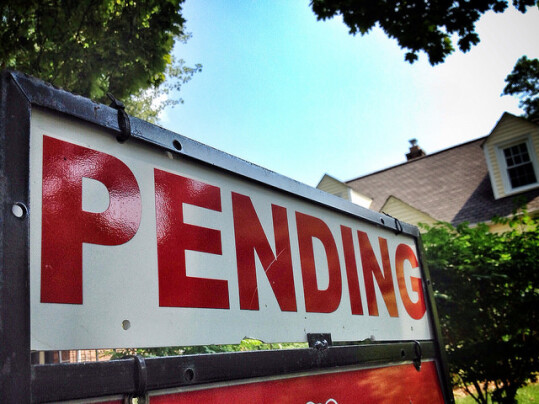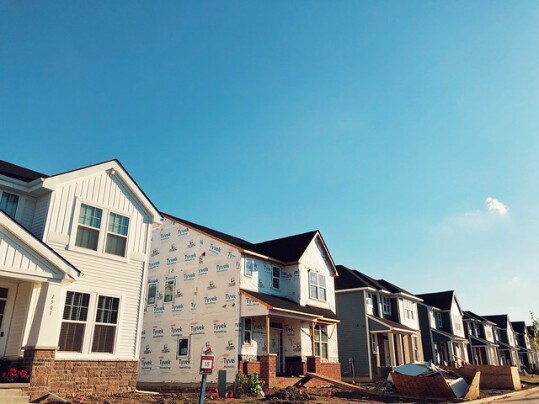When a buyer’s offer is accepted and a contract to buy is signed, that home’s sale is considered pending until the closing process has finished. Pending sales are considered a good indicator of future home sales, because there are typically weeks between the time when a contract is signed and the sale is finalized. That’s why the National Association of Realtors’ Pending Home Sales Index tracks them each month. In April, signings fell from the month before. Despite the month-over-month dip, however, Lawrence Yun, NAR’s chief economist, says contract signings are almost back to the level they were at before the coronavirus took hold. “Contract signings are approaching pre-pandemic levels after the big surge due to the lack of sufficient supply of affordable homes,” Yun said. “The upper-end market is still moving sharply as inventory is more plentiful there.” Yun expects the number of homes available for sale to improve as the year goes on. And as inventory improves, so should the number of home sales. (source)
Archive for May 2021
Demand For Loans To Buy Homes Increases
According to the Mortgage Bankers Association’s Weekly Applications Survey, demand for loans to buy homes rose last week from the week before. In fact, the MBA’s Purchase Index increased 2 percent from one week earlier. It was the second improvement in three weeks. Joel Kan, MBA’s associate vice president of economic and industry forecasting, says buyer demand remains high. “Purchase applications increased for the second time in three weeks, rebounding after a rather weak April with mostly weekly declines,” Kan said. “Demand is robust throughout the country, but home buyers continue to be held back by the lack of homes for sale and rapidly increasing home prices.” The gains came during a week when average mortgage rates were relatively flat. There was little movement for 30-year fixed-rate loans with both conforming and jumbo balances. Loans backed by the Federal Housing Administration, on the other hand, saw an increase from the week before. The MBA’s weekly survey has been conducted since 1990 and covers 75 percent of all retail residential mortgage applications. (source)
New Home Sales Retreat After Big Gains
Sales of newly built homes started this spring off strong. In March, they rose nearly 21 percent over where they were in February. But, as is often the case with new home sales, the spike was followed by a decline. In fact, according to new numbers from the U.S. Census Bureau and the Department of Housing and Urban Development, sales fell 5.9 percent in April. So what’s behind the volatility? Well, for one, new home sales numbers are based on sales agreements or deposits taken, which can occur before a building permit is issued. In other words, the numbers are subject to revision because they include estimates. Which means, month-to-month data will see swings that typically level off as firmer numbers become available. For that reason, April’s decline is more likely indicative of a temporary setback than it is the start of a downward trend. Also in the April sales report, the median sales price of new homes sold during the month was $372,400. the average sales price was $435,400. (source)
How Long Will You Live In Your Next House?
If you’re shopping for a house this year, there’s likely a reason you’ve decided now’s the right time for you to buy. Maybe it’s because you no longer like the neighborhood you’re in or you need more space because your family’s grown since your last move. Whatever the reason, the list of things you want in your next home is mostly tied to the things you want and need right now. But, based on a new analysis of homeownership tenure from ATTOM Data Solutions, you might want to also think about your future needs. That’s because, the length of time the average homeowner lives in a house has been growing in recent years. In fact, in the early 2000s, homeowners typically stayed in a house just under four-and-a-half years. These days, it’s almost double that. At the end of last year, for example, the average homeowner had owned their home over eight years. And while it’s fallen slightly this year, it’s still climbing in some places – especially, the Midwest and South. In other words, the house you buy today might be your home for most of the next decade. Which means, you should probably give some thought to – not just what you need right now – but also what you might need over the next several years. (source)
Existing Home Sales Surpass Last Year’s Pace
There are a lower-than-normal number of previously owned homes available in today’s market, but that hasn’t stopped home buyers. In fact, according to the National Association of Realtors, sales of existing homes between January and April are 20 percent higher than they were during the same period last year. That’s despite the fact that April sales fell 2.7 percent from the month before. Lawrence Yun, NAR’s chief economist, says demand is strong. “Despite the decline, housing demand is still strong compared to one year ago, evidenced by home sales from this January to April, which are up 20 percent compared to 2020,” Yun said. “The additional supply projected for the market should cool down the torrid pace of price appreciation later in the year.” More homeowners are expected to list their homes for sale as COVID vaccinations are administered and Americans feel more comfortable showing their homes. As that happens, home-price increases and buyer competition are expected to moderate. (source)
Forecast Sees Improvement Ahead For Housing Market
Each month, Fannie Mae’s Economic and Strategic Research Group releases a forecast for the economy and housing market. According to their most recent release, the group sees improvement ahead. In fact, their forecast calls for home sales to increase 6.3 percent this year and new home construction to rise almost 25 percent higher than the year before. But despite the optimistic numbers, there are still challenges facing the market. Among the biggest is the lack of existing homes available for sale. Fewer homeowners are listing their homes and the pace of new home construction, while greatly improved, is being slowed by supply constraints and a shortage of available lots. That means, inventory issues will likely continue for the foreseeable future. Fortunately, Doug Duncan, Fannie Mae’s senior vice president and chief economist, says conditions haven’t affected mortgage rates. “This has yet to significantly affect mortgage rates, except to the extent that the rise in the 10-year Treasury since the beginning of the year contains an increased expected inflation component and has prevented mortgage rates from retreating further from their temporary recent peak,” Duncan said. (source)
Mortgage Demand Rises Week-Over-Week
According to the Mortgage Bankers Association’s Weekly Applications Survey, demand for mortgage loan applications rose 1.2 percent last week from the week before. But while the improvement is a welcome sign, it wasn’t due to an increasing number of Americans buying homes. Instead, the gains were mostly found in the refinance index, which rose 4 percent from one week earlier. Joel Kan, MBA’s associate vice president of economic and industry forecasting, says purchase-application demand is still suffering due to a lack of available homes for sale. “A decline in purchase applications was seen for both conventional and government loans,” Kan said. “There continues to be strong demand for buying a home, but persistent supply shortages are constraining purchase activity, and building material shortages and higher costs are making it more difficult to increase supply.” Also in the report, average mortgage rates were up from the week before, with increases seen for 30-year fixed-rate loans with both conforming and jumbo balances, loans backed by the FHA, and 15-year fixed-rate loans. Still, rates remain below where they were in late March and early April. (source)







